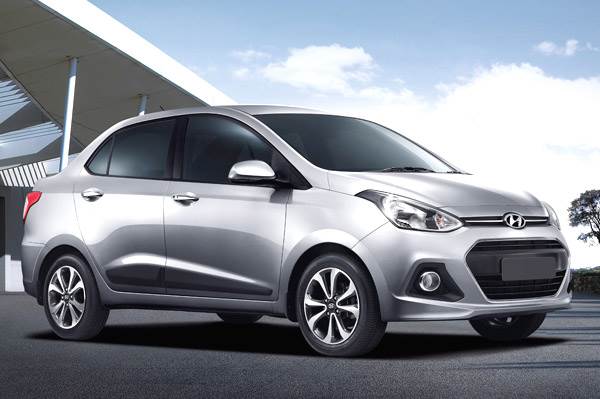The Indian compact sedan segment is all set to have its feathers ruffled again, with a new entrant from Hyundai's stable – the Xcent – which has just gone on sale. It’s derived from the very successful Grand i10, and all of the hatchback’s hallmarks have been carried forth – good legroom in the back, lots of features and a quality interior. But this segment already has two major players – Maruti’s Swift Dzire, for a time the second-best selling car in India, and Honda’s Amaze, which once boasted of being the most fuel efficient car in the country. The new Hyundai's Xcent will have these two to answer to, so how does it square up ? Let’s find out.
The Hyundai Xcent gets the same 1.2-litre petrol and 1.1-litre diesel engines as the Grand i10, which is important, as both the Maruti and the Honda have capable petrol and diesel powerplants. The petrols first – all three displace 1.2 litres, all have four cylinders, all are equipped with variable valve timing, and all can be had with the option of an automatic gearbox, apart from the standard five-speed manual. Hyundai’s punchy 1.2-litre Kappa2 engine makes 82bhp and 11.6kgm of torque, which is a shade shy of the Dzire’s K12 engine, which produces 86bhp and the same amount of torque. Honda’s 1.2 i-VTEC engine makes more power at 88bhp, but marginally less torque at 11.11kgm. Additionally, while the Xcent and Dzire use four-speed automatic gearboxes, the Amaze uses a five-speed automatic.
The diesel engines are where things get a bit different, although all are mated to five-speed manual gearboxes. The Xcent uses a 1.1-litre, three-cylinder CRDi engine, the Dzire the Fiat-sourced 1.3-litre four-cylinder DDiS engine, and the Amaze Honda’s developed-for-India 1.5-litre, four-cylinder i-DTEC engine. The differences in displacement reflect in their outputs as well, the Hyundai producing 71bhp and 18.4kgm (1bhp and 2.1kgm more than the Grand i10), the Maruti 74bhp and 19.4kgm and the Amaze a solid 98.6bhp and 20.4kgm of torque. However, each engine has its quirks, and the figures don’t tell the whole story. The Amaze engine, though very linear, lacks that torquey punch and is very loud. The Dzire suffers from a bit of lag, and – at least in the Grand i10 – Hyundai’s new small diesel engine, though a tad underpowered, is very responsive in the city.
All three cars are adapted from existing hatchbacks, and we feel that Honda did a better job than Maruti at adding a boot to its two-box car. This is largely because Honda’s starting point – the Brio, was much shorter than Maruti’s – the Swift, and so the designers had a lot more room to work with before hitting the four-metre cut-off length. The Grand i10’s length is in between the Swift and the Brio’s, so Hyundai’s designers had quite a bit of space left to work with when penning the Xcent. Still, the two Hyundais are identical up to the rear doors and share the same wheelbase. The boot has been well integrated, however, and its 407-litre volume is best in class, beating the Dzire’s 316 litres and the Amaze’s 400 litres.
As Hyundais are often known to do, the Xcent really wins things back on the equipment front, when comparing top-of-the-line variants at least. It takes the Grand i10’s already substantial kit count and adds to it features like a rear-view camera, automatic climate control and a rear seat armrest with cupholders. It also gets segment-first features like keyless entry, push-button start, a rear AC vent and 1GB of onboard storage for its audio system. Then there are rear parking sensors, CD, USB, Aux and Bluetooth-enabled audio system and electric folding mirrors, among others.
Comparatively, the top-end Amaze does get electric folding mirrors and a USB and Aux-enabled audio system, but there’s no CD player or Bluetooth. It also misses out on climate control, which the top Dzire also gets, and though the Maruti gets a CD player, Aux-in and USB, it misses out on Bluetooth. It also has to be said that the design and layout of the Amaze’s cabin feels a bit Spartan compared to the plush and premium looking interiors of the Xcent and the Dzire. Top variants of the Honda and Maruti come with two airbags and ABS, but these are available only as paid options on the top Xcent SX. What's more, although you can have ABS on the middle Xcent S trim as a paid option, airbags are not even optional on either of the two lower trims.
It’s not going to be easy for Hyundai to tackle one of the hottest segments in the country, as Maruti and Honda have entrenched themselves firmly with quality products and attractive prices. But as we’ve seen before, Hyundai’s trademark combination of good styling and lots of equipment seems to work well with Indian buyers, and with an attractive introductory price range of Rs 4.66-7.38 lakh (ex-showroom, Delhi), we could have a serious battle on our hands very soon.




Comments
Member Login
Personal Details
No comments yet. Be the first to comment.